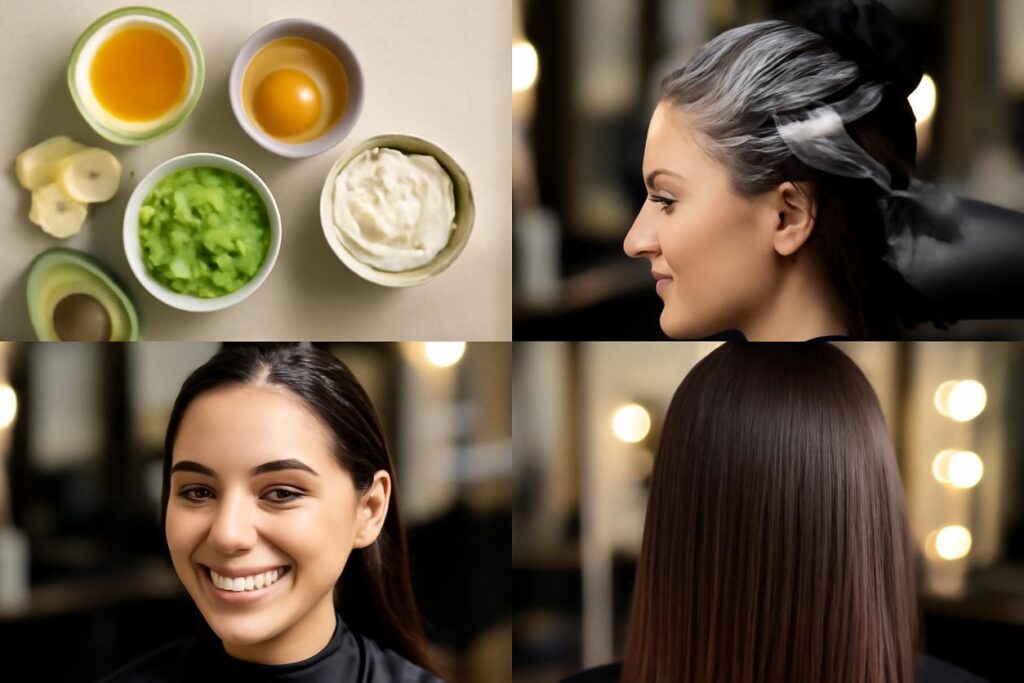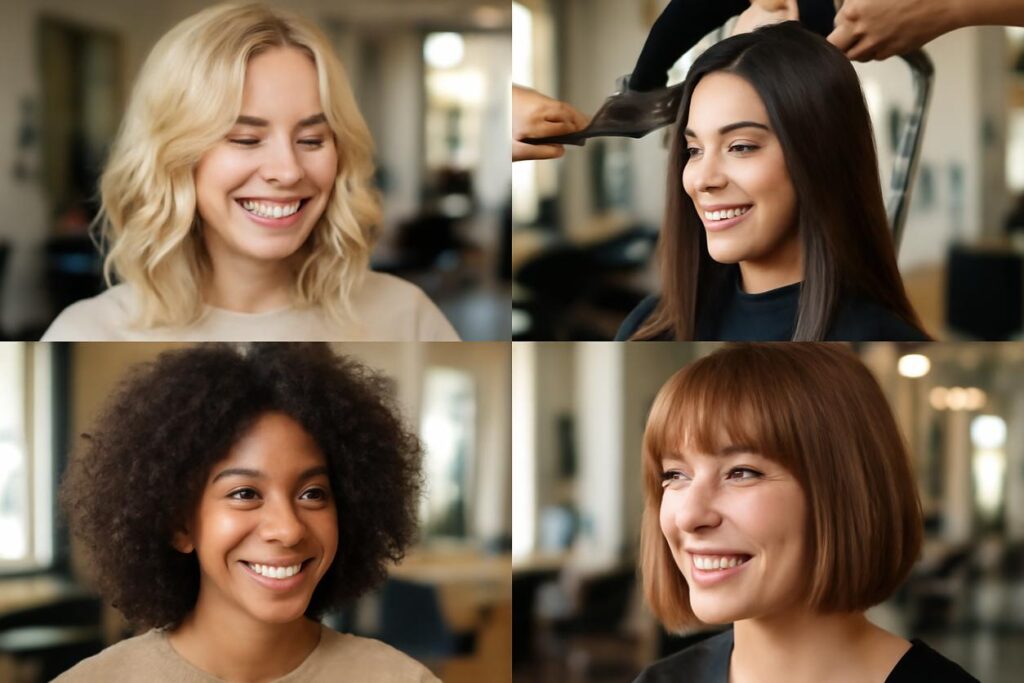Why overnight hair care makes a difference
Imagine waking up with hair that’s already a step ahead—smoother, more hydrated, and less prone to breakage. This isn’t about complicated morning routines; it’s about the transformative power of overnight hair care. While you sleep, your body enters a state of repair and regeneration. This is the perfect time to give your hair the focused attention it needs to thrive. Your hair cuticles are more receptive to absorbing nutrients from masks and oils, and since you’re not exposing your hair to environmental stressors like sun or pollution, treatments can work uninterrupted for hours.
Adopting a simple nighttime routine does more than just improve hair health; it saves you precious time in the morning. By protecting your hair from friction and applying targeted treatments before bed, you can significantly reduce frizz, tangles, and dullness. This means less time spent wrestling with your hairbrush and heat styling tools. In short, a consistent overnight hair care strategy is a low-effort, high-reward investment in the long-term health and appearance of your hair.
How to assess your hair’s overnight needs
Before you can build an effective routine, you need to understand what your hair is asking for. Different hair types have unique needs, especially when it comes to an extended treatment period like overnight. Take a moment to assess your hair’s texture, density, and common concerns. Is it prone to getting greasy at the roots? Does it feel dry and brittle at the ends? Do your curls lose their shape while you sleep? Answering these questions will help you tailor your overnight hair care for maximum benefit.
For straight and fine hair
Fine and straight hair can easily be weighed down by heavy products and is prone to tangles and oiliness. The primary goal for your overnight routine is to protect delicate strands and maintain volume without causing greasy roots.
- Main Concerns: Oiliness, flatness, tangles, and breakage.
- Overnight Goals: Protect from friction, lightly moisturize ends, and preserve natural volume. Avoid heavy oils or creams near the scalp.
- Key Strategy: Focus on protective styling like a loose, high bun (a “top knot”) using a silk or satin scrunchie. A light, water-based leave-in spray on the ends can help with hydration without adding weight.
For wavy and loose curls
Wavy hair sits in a delicate balance between straight and curly. The challenge is to enhance your natural wave pattern and fight frizz without disrupting the S-shaped curves. Your overnight hair care should focus on moisture and definition.
- Main Concerns: Frizz, loss of wave pattern, dryness.
- Overnight Goals: Preserve waves, reduce frizz, and maintain moisture balance.
- Key Strategy: A loose braid or twisting your hair into two loose buns can help maintain your wave pattern. Applying a small amount of curl cream or a lightweight leave-in conditioner before styling will help lock in moisture and combat frizz.
For defined curls and coils
Curly and coily hair types are naturally drier and more fragile than other hair types, making them susceptible to breakage and moisture loss. Your nighttime routine is crucial for hydration, definition, and protection.
- Main Concerns: Extreme dryness, shrinkage, frizz, breakage, and tangled knots.
- Overnight Goals: Maximize moisture retention, protect curl pattern, and prevent breakage from friction.
- Key Strategy: The “pineapple” method is a game-changer. Gather your hair into a very high, loose ponytail on top of your head to protect the curls. Use a leave-in conditioner or a light oil to seal the ends. For extra protection, sleeping in a silk or satin bonnet or scarf is highly recommended.
Nighttime oils and leave on treatments: when to use them
Leave-on treatments like oils, serums, and masks are the powerhouse products of any overnight hair care routine. They offer a concentrated dose of nutrients and moisture over an extended period. However, knowing when and how to use them is key to avoiding greasy, weighed-down hair.
- Lightweight Serums and Leave-In Conditioners: These are great for frequent use (2-4 times a week), especially for fine to medium hair types. Apply a pea-sized amount to the mid-lengths and ends to detangle, fight frizz, and add a touch of moisture without overwhelming the hair.
- Nourishing Oils (Argan, Jojoba, Coconut): Best used as a weekly or bi-weekly treatment. Oils are fantastic for sealing moisture into dry, porous, or coarse hair. Apply sparingly to the ends of your hair to prevent split ends. For a deeper treatment, you can apply more generously and wash it out in the morning.
- Intensive Overnight Masks: Reserve these for a deep conditioning treatment once a week or every two weeks, particularly if your hair is damaged, color-treated, or very dry. These are richer and thicker, designed to deeply penetrate the hair shaft. Always protect your pillowcase with a towel when using a heavy mask.
DIY overnight masks from kitchen staples
You don’t need expensive products to give your hair a nourishing boost. Some of the most effective ingredients for your overnight hair care journey can be found right in your kitchen. Remember to always perform a patch test on a small area of your skin before applying a new mixture to your entire head.
- For Intense Moisture (Dry or Damaged Hair): Mix two parts plain yogurt with one part honey. Yogurt’s lactic acid gently cleanses while its fats moisturize, and honey is a natural humectant that draws moisture into the hair. Apply to damp hair, cover with a shower cap, and rinse thoroughly in the morning.
- For Strength and Shine (All Hair Types): Whisk one egg with a tablespoon of olive oil. Eggs are packed with protein, the building block of hair, which helps fortify weak strands. Olive oil adds softness and shine. This mask is potent, so use it no more than once every two weeks to avoid protein overload.
- For a Soothed Scalp (Itchy or Flaky Scalp): Mix a few tablespoons of aloe vera gel with a few drops of tea tree oil. Aloe vera is incredibly soothing and hydrating, while tea tree oil has clarifying properties. Focus the application on your scalp, massaging it in gently.
Sleep friendly styling methods that reduce damage
Tossing and turning at night can create friction between your hair and your pillowcase, leading to tangles, frizz, and breakage. Protective styling is a non-negotiable part of overnight hair care. The goal is to keep your hair contained and minimize movement without causing tension on your scalp.
- The Loose Braid: A simple, classic choice for straight and wavy hair. A single loose braid prevents tangles and can create soft, heatless waves by morning. Ensure it’s not too tight to avoid stress on your hairline.
- The Pineapple: Ideal for those with curly and coily hair. As mentioned, this involves gathering your hair into a very high, loose ponytail on top of your head using a gentle scrunchie. This protects the curl pattern and prevents it from getting crushed while you sleep.
- The Top Knot or Loose Bun: A great option for fine, straight, or wavy hair. Twist your hair loosely into a bun at the very top of your head. This keeps hair off your neck and prevents tangles. Always use a soft scrunchie (like silk or satin) instead of a tight elastic to avoid creating a dent.
Pillowcase and bedding choices that protect hair
One of the easiest yet most impactful upgrades you can make to your overnight hair care routine has nothing to do with products—it’s about the surface your hair rests on. Your choice of pillowcase can make a huge difference in the health and appearance of your hair.
Cotton pillowcases are very absorbent. They act like a sponge, drawing moisture out of your hair and skin throughout the night. This can leave your hair feeling dry and brittle. The slightly rougher texture of cotton can also snag and pull on hair strands, leading to frizz and breakage.
Silk or satin pillowcases, on the other hand, provide a smooth, low-friction surface. Your hair glides over the fabric instead of rubbing against it. This simple switch helps to:
- Reduce frizz and flyaways.
- Minimize tangles and breakage.
- Help hair retain its natural moisture.
- Preserve your hairstyle for longer.
If a new pillowcase isn’t an option, a silk or satin bonnet, scarf, or turban offers the same protective benefits.
A simple nightly routine for hectic evenings (step by step)
Even on the busiest of days, you can spare five minutes for a basic overnight hair care routine. Consistency is more important than complexity.
- Step 1: Detangle Gently (1 Minute): Starting from the ends and working your way up to the roots, gently brush or comb your hair to remove any knots. Use a wide-tooth comb or a brush designed for detangling to minimize breakage.
- Step 2: Apply a Lightweight Product to Ends (1 Minute): Warm a pea-sized amount of a lightweight serum, leave-in conditioner, or hair oil between your palms. Gently smooth it over the bottom half of your hair, focusing on the ends, which are the oldest and most fragile part.
- Step 3: Secure in a Protective Style (2 Minutes): Put your hair into a loose, sleep-friendly style like a braid, top knot, or pineapple. Use a soft, snag-free hair tie like a silk or satin scrunchie.
- Step 4: Sleep on a Hair-Friendly Surface (1 Minute): Whether it’s a silk pillowcase, a bonnet, or a scarf, ensure your hair is protected from friction overnight.
A weekly schedule to track progress
To see real results from your overnight hair care efforts, it helps to be consistent. Here is a sample weekly plan you can adapt for your hair type starting in 2025. This schedule prevents product overload while ensuring your hair gets what it needs.
| Day of the Week | Overnight Hair Care Action | Notes |
|---|---|---|
| Monday | Simple Routine (Detangle, Ends Serum, Protective Style) | A simple start to the week. |
| Tuesday | Light Hydration (Leave-in spray/cream) | Focus on moisture, especially for wavy/curly types. |
| Wednesday | Simple Routine | Give your hair a break from heavier products. |
| Thursday | Deep Treatment (Overnight Mask or Oil) | Plan this for a night before a wash day. |
| Friday | Simple Routine | Protect your hair for the weekend. |
| Saturday | Light Hydration or Simple Routine | Assess your hair’s needs—add moisture if it feels dry. |
| Sunday | Scalp Care (Scalp massage or light scalp serum) | Prepare for the week ahead with a healthy scalp. |
Troubleshooting common overnight issues
- “My hair feels greasy or weighed down in the morning.”
This usually means you’re using too much product or a product that’s too heavy for your hair type. Try using half the amount, or switch to a more lightweight, water-based formula. Also, ensure you are concentrating products on the mid-lengths and ends, avoiding the scalp.
- “My protective style leaves dents in my hair.”
Your hair tie is likely too tight or you’re securing the style too firmly. Switch to a silk or satin scrunchie and make sure your bun or braid is loose and comfortable, with no pulling at the scalp.
- “My curls still look flat or frizzy.”
Your curls may need more moisture or better protection. Try applying a bit more leave-in conditioner before putting your hair in a pineapple. Also, ensure your silk bonnet or scarf stays on all night. If it slips off, look for one with an adjustable band.
Safety, allergies and product caution notes
Your well-being is paramount. Whether you’re using store-bought products or DIY remedies, safety should always come first.
- Always Patch Test: Before applying any new product or DIY concoction to your entire scalp and hair, apply a small amount to an inconspicuous area, like behind your ear or on your inner arm. Wait 24 hours to ensure you don’t have an allergic reaction, such as redness, itching, or irritation.
- Check Ingredients: Be mindful of common allergens, especially in DIY recipes (e.g., nuts, dairy, gluten). Read product labels carefully. If you have known sensitivities, consult resources from organizations like the American Academy of Dermatology for guidance on hypoallergenic options.
- Listen to Your Hair: Not every trend or product will work for you. If your hair feels worse after a treatment—overly dry, brittle, or greasy—it’s a sign to stop and reassess. Effective overnight hair care is about personalization, not just following a formula.
Further reading and references
Building a deep understanding of hair health can empower you to make the best choices for your unique needs. For those interested in diving deeper, these resources offer valuable, evidence-based information.
- For Professional Insights and Hair Science: Hair care professionals and trichologists offer a wealth of knowledge on hair structure and health. Platforms like Rich Hair UK provide expert articles and insights into the science behind hair care.
- For Nutritional Science: The link between diet and hair health is well-documented. To understand how vitamins and minerals impact your hair, explore studies and articles on databases such as the National Center for Biotechnology Information (NCBI), which hosts numerous peer-reviewed papers on hair nutrition.
- For Dermatological Health: Scalp health is the foundation of healthy hair. For medical-grade information on scalp conditions and ingredient safety, the American Academy of Dermatology Association is an authoritative and reliable source.






